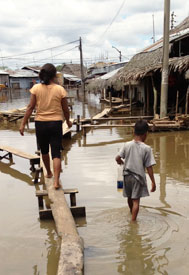Identifying leptospirosis and saving patients
January / February 2013 | Volume 12, Issue 1

Courtesy of Dr. Joseph Vinetz
Fogarty-supported researchers
are studying the potentially lethal
disease leptospirosis,
increasingly common in tropical
regions like the Amazon but
also occasionally found in the
U.S. and Europe.
By Cathy Kristiansen
A tangle of factors, from floods and farming to animal urine and contaminated water, help spread the
Leptospira bacterium to humans, especially in tropical areas but also in the U.S. and elsewhere. It is hard to diagnose, being confused in endemic areas with influenza, dengue fever or a viral hemorrhaging disease, and in some places kills more people than dengue and malaria combined.
To increase understanding and awareness of leptospirosis, Dr. Joseph Vinetz, of the University of California, San Diego (UCSD), launched a collaboration in 2004 between his university and Universidad Peruana Cayetano Heredia in Lima, to conduct research in the Amazon area of Peru. "We were able to start a laboratory, get field sites and start training lab technicians, biologists, nurses and ecology students. We took the field from literally zero to 100 over the last decade," Vinetz said.
Vinetz, who jokes he is known as "Lepto Joe" for devoting his career to leptospirosis research, was supported by an
Ecology and Evolution of Infectious Diseases grant, designed by Fogarty and the National Science Foundation to deepen understanding about how human-induced environmental changes spur the emergence and transmission of infectious diseases. He also received Fogarty funding for the related training of students at Cayetano University with a
Global Infectious Disease research training grant and some support from the National Institute of Environmental Health Sciences (NIEHS).
The grants were critical to jump-starting recognition of the disease in Peru, where it is endemic and is spread primarily by rat urine. In some areas, nearly 30 percent of villagers have the bacteria in their blood during the wettest season and researchers estimate 1 to 2 percent of them die. The initiative, which includes both Peruvian and U.S. investigators, has generated expertise, data and published papers that have widened recognition of the difficult-to-diagnose disease and resulted in quicker treatment with simple but lifesaving antibiotics, Vinetz said.
"A huge part of the project was research capacity building," he noted, citing expertise in infectious disease epidemiology, mammalian ecology, public health, medical microbiology and molecular epidemiology, among other specialties. Some of the biologists and lab technicians now work in the Ministry of Health and one trainee, Dr. Jessica Ricaldi, of Cayetano University, is building up her own laboratory in Lima that includes a veterinary student and other trainees, Vinetz noted.
Leptospirosis, an emerging pathogen, thrives in tropical and subtropical areas, but has also shown up in wild boars in Berlin, Germany, and rats in Baltimore, Md., in the U.S. It spreads more readily after floods, which increase standing surface water, and after droughts when humans and animals both frequent places where water is available. Humans pick up the pathogen after infected wild and domesticated animals urinate in water or soil, so high-risk groups include rice farmers, sewage workers, veterinarians and anyone walking barefoot.
"Leptospira don't just contaminate the environment, they have evolved to be part of the environment. That's a new area of research," Vinetz said. "There are literally hundreds of different varieties of
leptospira that seem to be host-adaptive to various animals. Now we are working on how the environment, the wet soils and water actually select for diverse
leptospira and increase the bacteria's virulence."
The research infrastructure and expertise established in Peru with Fogarty support has opened the door to other funding, including a biodefense grant from the NIH's National Institute of Allergy and Infectious Diseases to investigate the bacterial disease bucellosis. Meanwhile, researchers in Peru forge ahead gathering evidence. "It provides data about disease risk," Vinetz said. "Without data, public health authorities will take no action."
More Information
To view Adobe PDF files,
download current, free accessible plug-ins from Adobe's website.